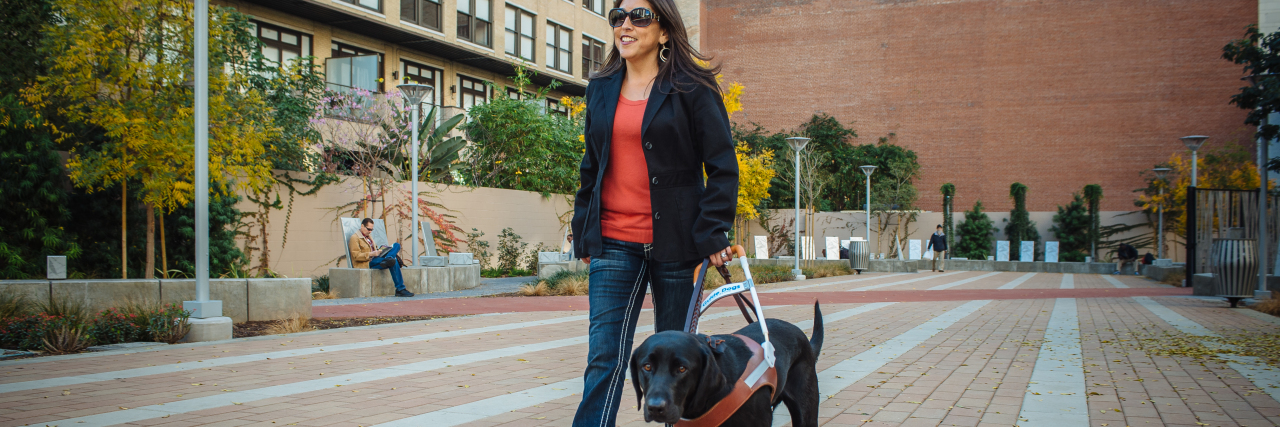The Joys and Challenges of Being a Guide Dog Handler
September is National Guide Dog Month, so Guide Dogs for the Blind (GDB) of San Rafael, Calif., has released results of its recent North American survey of 375 blind and visually impaired alumni. The survey was the largest of its kind in GDB’s history, and the findings reveal both the joys and obstacles for guide dogs and their blind partners.
The survey results revealed insights into the progress that guide dog teams have made in terms of integrating into society. But the results also illuminated many of the challenges those of us who are blind or visually impaired must face in our daily lives, and some of the misconceptions sighted people have about our guide dogs (and about us). For those who use a guide dog, the survey also validated that we are extremely fortunate in reaping the many benefits of the strong canine-human connection that comes with being part of a guide dog team.
Like me, respondents uniformly reported that guide dogs are not only amazing companions, but they also serve as great ice breakers with the general public. I can personally attest that my guide dog, Wills, serves as a social bridge. When I’m traveling with my guide dog, people are friendlier to me. Some who would probably be uncomfortable about approaching a blind person are more than happy to strike up a conversation with me about my dog. Respondents also said that guide dogs help them travel with greater efficiency and speed than using a cane. One person shared that “It’s almost like we’re flying or dancing.” Other respondents noted the tangible emotional benefits, with one stating, “My dog inspires me to be my best self.”
Strong words, but I echo this sentiment. When you combine the social connection aspect with the enhanced independence and mobility a guide dog can give you, it definitely adds up to the whole being greater than the sum of its parts.
Some of the key survey findings include:
• Understanding of etiquette of how to approach a guide dog is getting better but still has room to improve — 32 percent of respondents deemed understanding among the sighted public as good or excellent. Children often are the most attuned and respond properly to guide dogs. Poor etiquette from other adult passengers on public transit was the number one complaint.
• Unemployment and underemployment continue to be an issue for blind folks in most locales – 63 percent rated it as fair or poor in their locales, with multiple respondents noting that most employers have the “false idea that vision is everything.”
• San Francisco was named as the best travel destination for guide dog teams, with Portland coming in second. Both were cited as being “blind-friendly” and “walkable.”
• Ride-sharing services such as Uber and Lyft are equally liberating and vexing. Circa 50 percent regularly use ride-sharing services, but many report frustration with drivers refusing them because of their dogs. “I love Uber, but they don’t love me,” was a common refrain among respondents.
These findings were not surprising to me. I believe many of the issues with etiquette stem from a misunderstanding of guide dogs. Many people think guide dogs are constantly working. Nothing could be further from the truth. As someone who has had four guide dogs, I can tell you that they become part of the family and spend a lot of time playing and enjoying the companionship of their handlers.
Not understanding the difference in work versus play leads many people to either avoid guide dogs altogether or pet the dog while they are working, which can be dangerous. If the dog is in harness and guiding a person, you can probably assume they are working. If they’re taking a nap while their handler is having coffee, they probably aren’t working. You should always ask first, however, before interacting with any dog.
What I appreciated even more about the survey than the fact that it validated my experience as a guide dog user was that it showed that at the end of the day, we are just people, with likes and dislikes – and joys and obstacles – just like everybody else. It highlighted some areas where we need to educate the public to make life for visually impaired people smoother when we are out with our guide dogs. But it also reminded me of how lucky we are to experience the life-changing partnership of having a guide dog.
Learn more at Guide Dogs for the Blind.
We want to hear your story. Become a Mighty contributor here.

